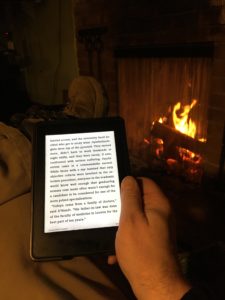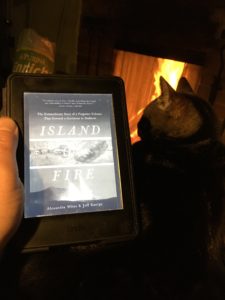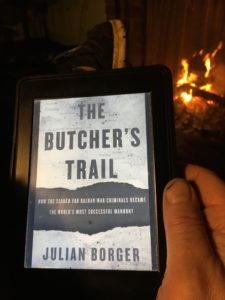
If you’re a reader like me, I bet you love reading by a nice, warm fireplace on a quiet evening, with just you, a comfortable chair, a good book, and a glowing fire in front of you. Escaping the tyrannies of social media and rapid-fire text messaging by spending an evening much like our forefathers did is the perfect antidote for these hyper-connected and hyper-accelerated modern times we now live in.
Before you all start thinking I’m all cool and retro, I need to be honest. There’s no central heat in the farmhouse, so a fire in the fireplace is a must in the evenings—especially at this time of year. None of us are avid television watchers, which is good because our reception is rumored to be awful. With no cable service in our area, we’re unable to get high-speed Internet service and are forced to rely on satellite for both Internet and cell phone. Being both terribly slow and having a hideously prohibitive data cap, our satellite internet service makes streaming, um, problematic (at best). So, with one’s entertainment options limited, why not read in the evening?

Reading by the evening fire hearkens back to an earlier time—not just before Facebook, Twitter, and smart phones, but even radio and television, which are now trailing-edge technologies by today’s standards. But, although the majority of Americans were literate by the mid 20th century, books were a premium, especially in rural parts of America. As late as the late 19th century in America, many large cities lacked well-stocked public libraries. Only the wealthy, with their vast personal libraries, or those in learned professions (e.g. clergy, physicians, and academics) had extensive access to books and other reading material. Affordable mass-produced paperback editions would not become widely available in the United States until after the Second World War. If you were a farmer, industrial worker, or laborer—assuming you were literate—you had to be content with the few books currently in your household. (Traditionally, this was the family Bible in many households). If you were lucky, you could borrow books from friends or purchase them from a bookseller, providing you possessed enough disposable income.
So, exactly what am I reading in the evenings by the fire? I tend to read nonfiction, everything from history to comparative religion to politics (both domestic and foreign). I have a soft spot for memoirs and autobiographies by foreign writers and immigrants. Over the last five years or so, I’ve been branching out and reading more international fiction—especially European crime stuff—not just from Scandinavia, but from all over Europe, including Belgium and Hungary.

But that’s not all I’m reading, since I’m a member of two discussion groups, each with assigned readings. One of these groups, sponsored by World Oregon, meets every two weeks at the Rose City Book Pub in Portland, Oregon to discuss long-form articles focused on global topics such as Brazilian political scandals, Brexit and organized crime in Russia. The other group is one I joined last summer when a sociology professor at the local university invited me to join his tri-weekly reading group to discuss the works of Kant, Hegel and Marx, as well as more recent thinkers like Roy Bhaskar and how we can apply their writings to today’s political and economic situation.
If reading by firelight doesn’t hearken back to earlier centuries, then participating in two discussion groups—themselves modern day reincarnations of the salons of the 17th and 18th centuries—certainly does.
While I’m tempted to think that my reading by the fire in the evenings is a novel activity—perhaps even a trend-setting reaction against today’s over technological world—I need to think twice. As the wise Koheleth wrote so long ago, there’s nothing new under the sun.
[Ed. note: If you’ve ever tried to actually read a book solely by firelight, you know that it is not especially comfortable—especially for post-40-year-old eyes. So, beyond limited access to books and a dearth of leisure time for most Americans, the cost of candles or lamp oil meant that evening reading was mainly for the wealthy. This remained the case until affordable electric lighting began appearing in American towns and cities in the early 1900s. Even then, rural America (home to 60% of the population in 1900) lagged far behind. Although our farmhouse appears to have been wired for electric lighting when it was built in 1925, this was unusual. Many American farms did not get electricity until well after the Second World War.
The internet has increased access to books for everyone, but it has been a game-changer for rural Americans. Even with pokey internet access like we have, the world’s booksellers are all easily accessible from one’s armchair. The advent of e-books has increased accessibility even further, as it takes no more than a minute or two—even for us—to download virtually any book in print to one’s e-reader. And on top of that, many public libraries are now making e-books available to borrow through programs like Overdrive. Fireside reading has never been better! –Mike]
